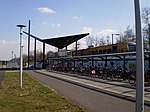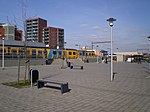Loenen, Apeldoorn
ApeldoornFormer municipalities of GelderlandGelderland geography stubsPopulated places in GelderlandWorld War II cemeteries in the Netherlands

Loenen is a village in the Dutch province of Gelderland. It is located in the municipality of Apeldoorn, about 10 km southeast of that city. Loenen was a separate municipality until 1818, when it was merged with Apeldoorn.
Excerpt from the Wikipedia article Loenen, Apeldoorn (License: CC BY-SA 3.0, Authors, Images).Loenen, Apeldoorn
De Kempe, Apeldoorn
Geographical coordinates (GPS) Address Nearby Places Show on map
Geographical coordinates (GPS)
| Latitude | Longitude |
|---|---|
| N 52.116666666667 ° | E 6.02 ° |
Address
De Kempe 8
7371 BV Apeldoorn
Gelderland, Netherlands
Open on Google Maps











